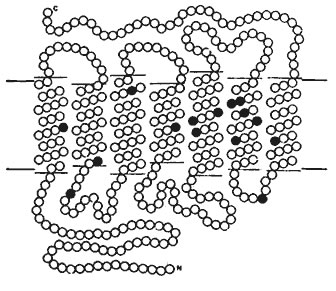A page from the "Causes of Color" exhibit...
How do people get colorblindness and how many people have it?

|
||||||||||||||||||||||||||||||||||
People with normal color perception have three different types of cones. Each type of cone is tuned to perceive predominantly long wavelengths (reddish), middle wavelengths (greenish), or short wavelengths (bluish), referred to as L-, M-, and S- cones. The cone cells on the retina are the crucial physical components of seeing color. Our minds determine what "color" we are seeing by determining the ratio between signals from different types of cones. In people with colorblindness, a type of cone is either missing, or has a different spectral sensitivity.
Incidence
Approximately 5% to 8% of men and 0.5% of women are born colorblind, or one out of twelve men and one out of two hundred women. People who are protans (red weak) and deutans (green weak) comprise 99% of this group.
An unusual type of colorblindness occurs in the mind, not the eye. This is a drawing by a patient who was unable to see the world in color after a cerebral accident. The patient was an artist, and the drawings were made from memory. The drawings represent (clockwise): a banana, a tomato, a cantaloupe and leaves. Interestingly, this is analogous to the luminance-based paintings of some of Picasso’s work.
Incidences of colorblindness
Cause
Congenital color vision deficiencies overwhelmingly affect the L-cones or the M-cones. Full color blindness is relatively rare. L-cone and M-cone deficiencies are often collectively known as red-green colorblindness, because they reduce the ability to distinguish those two colors. Deficiencies involving the S-cones are much more rare and are often called yellow-blue colorblindness.
Colorblindness is primarily congenital. However, colorblindness can also be acquired as a result of disease or accident, as in the case of the artist of the picture shown. In this case, the color vision deficiency is caused by disruption to the neural pathways between the eye and the vision centers of the brain, rather than by loss of cone function in the eye. For example, achromatopsia, the loss of all color vision, can be acquired as a result of brain damage, and Parkinson’s disease commonly induces symptoms that are similar to tritanopia.

The L- and M-cone opsins are highly homologous. The open circles represent identical amino acids and the solid circles represent amino acid substitutions between the L- and M-cone opsins. The human L- and M- cone opsins both consist of 364 amino acids and are identical at all but 15 sites. Their absorption maxima differ by only 31 nm and this difference in spectral sensitivity is thought to be attributed to 7 amino acid residues.
What is the genetic cause for anomalous trichromacy?
Anomalous trichromacy, the most common type of colorblindness, is characterized by a shift in the sensitivity of one or more cone pigments. For reasons having to do with the genetic coding of color vision, these shifts overwhelmingly affect the L-cones and M-cones, and the shift is typically from the one toward the other. In other words, protanomaly makes the L-cone more like the M-cone, and deutanomaly makes the M-cone more like the L-cone. L- and M-cones distinguish between long and medium wavelengths.
The L- and M-cone opsin genes lie adjacent to one another, head to tail, on an arm of the X-chromosome. The genes are responsible for the make-up of the cone opsin (protein). The cone opsin, along with retinal, makes up the pigment.
Intragenic recombination between the L- and M-cone genes is common and can lead to the production of hybrid or fusion genes, some of which code for anomalous pigments. If there is variation in the L- and M-cone pigments, caused by a difference in their amino acid sequence, the differences in these two pigments can become less marked and their absorption maxima can be shifted closer together. Generally, the ability to discern reds and greens decreases as the absorption maxima of the cones shift closer together.
It is believed that, since the gene responsible for the S-cone opsins (discerning blue and yellow) does not have any neighboring DNA with a similar sequence, tritanomaly is caused by some kind of mutation of the gene. Given the complexity of genetic research, the role of genes in colorblindness is not yet fully understood.
Inheritance in anomalous trichromacy
Protanomaly and Deutanomaly
Protanomaly and deutanomaly (sometimes referred to as red-green colorblindness) are caused by anomalies in the X chromosome. Since women have two X chromosomes while men have an X chromosome and a Y chromosome, this colorblindness is much more common in men; women must have defects in both chromosomes before they exhibit this colorblindness. However, because the gene is recessive, a woman who is not colorblind, but has a colorblindness defect in one X chromosome, is a carrier of this colorblindness.
The animation above illustrates the statistical likelihood of inheriting colorblindness.
- Male children of a carrier mother and non-colorblind father have a 50% probability of being colorblind and female children have a 50% probability of being carriers.
- Male children of a father with colorblindness and a carrier mother have a 50% likelihood of being colorblind, and their female children are either carriers or colorblind.
- Male children of a father with colorblindness and a non-colorblind mother will not inherit colorblindness, but all of the female children will be carriers.
- Male children of a non-colorblind father and a colorblind mother will be colorblind and all the female children will be carriers.
- All the children of two red-green colorblind parents will be red-green colorblind.
Tritanomaly
This incidence of tritanomaly (sometimes referred to as blue-yellow colorblindness) is also genetic but is not gender-linked. Tritanomaly is found equally in men and women. The gene coding for the blue receptors lie on a chromosome that is found equally in men and women. It is believed that the colorblindness is caused by a simple mutation of the gene.




